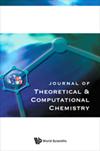NLO应用中基于过渡金属的新型推挽分子的理论研究和用DFT计算确定ICT机制
IF 2.4
Q3 Computer Science
Journal of Theoretical & Computational Chemistry
Pub Date : 2020-06-23
DOI:10.1142/s0219633620500261
引用次数: 4
摘要
这项研究是基于对一些模型分子的评估。本研究的目的是对四个有机金属分子和一个有机分子进行非线性光学(NLO)改进。这些分子已经通过不同的泛函进行了多次计算:CAM–B3LYP、LC–BLYP、LC–wPBE、wB97X、M11、M06–2X、M08–HX和M08–SO。这些泛函给出了[公式:见正文]参数的三个分类顺序。CAM–B3LYP功能记录了[公式:见正文]参数和间隙之间非常好的一致性([公式:见图正文])。在880*10[公式:参见正文][公式:见文本]esu左右获得了显著的第一超极化率([公式,见文本])。分子内电荷转移(ICT)的机制显示了从供体基团到受体的能量传递,反之亦然。金属的取代影响[公式:见正文]电子在发色团水平上的位置。最后,受体和供体基团之间的芳香链的延长显示出显著的NLO改善。几个苯环的链的第一和第二超极化率([式:见正文]和([式∶见正文])分别为21663.16*10[式:见正文][式:见文本]esu和16464.65*10[式∶见正文][式:见案文]esu的数量级。本文章由计算机程序翻译,如有差异,请以英文原文为准。
Theoretical study of new push–pull molecules based on transition metals for NLO applications and determination of ICT mechanisms by DFT calculations
This study is based on the valuation of a few model molecules. The objective of this research is focussed on the nonlinear optical (NLO) improvement of four organometallic molecules and one organic molecule. These molecules have been subjected to several calculations by different functionals: CAM–B3LYP, LC–BLYP, LC–wPBE, wB97X, M11, M06–2X, M08–HX and M08–SO. These functionals gave three orders of classification of the [Formula: see text] parameters. The CAM–B3LYP functional recorded very good agreement between [Formula: see text] parameters and gaps ([Formula: see text]. Significant first hyperpolarizabilities ([Formula: see text] have been obtained around 880 * 10[Formula: see text][Formula: see text]esu. The mechanisms of intramolecular charge transfer (ICT) have shown energetic passages from donor groups to acceptors and vice versa. The substitution of metals influences the location of [Formula: see text] electrons at the level of the chromophores. Finally, the lengthening of the aromatic chains between the acceptor and donor groups shows significant NLO improvements. The first and second hyperpolarizabilities ([Formula: see text] and ([Formula: see text] for a chain of several benzene rings are of the order of 21,663.16 * 10[Formula: see text][Formula: see text]esu and 16,464.65 * 10[Formula: see text][Formula: see text]esu, respectively.
求助全文
通过发布文献求助,成功后即可免费获取论文全文。
去求助
来源期刊
CiteScore
1.70
自引率
0.00%
发文量
0
审稿时长
3 months
期刊介绍:
The Journal of Theoretical and Computational Chemistry (JTCC) is an international interdisciplinary journal aimed at providing comprehensive coverage on the latest developments and applications of research in the ever-expanding field of theoretical and computational chemistry.
JTCC publishes regular articles and reviews on new methodology, software, web server and database developments. The applications of existing theoretical and computational methods which produce significant new insights into important problems are also welcomed. Papers reporting joint computational and experimental investigations are encouraged. The journal will not consider manuscripts reporting straightforward calculations of the properties of molecules with existing software packages without addressing a significant scientific problem.
Areas covered by the journal include molecular dynamics, computer-aided molecular design, modeling effects of mutation on stability and dynamics of macromolecules, quantum mechanics, statistical mechanics and other related topics.

 求助内容:
求助内容: 应助结果提醒方式:
应助结果提醒方式:


